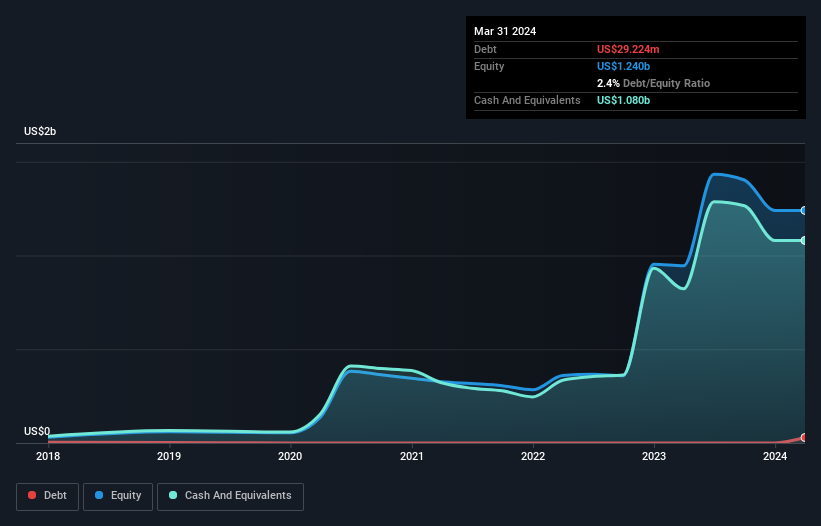- United States
- /
- Biotech
- /
- NasdaqGS:PCVX
Vaxcyte (NASDAQ:PCVX) Has Debt But No Earnings; Should You Worry?

David Iben put it well when he said, 'Volatility is not a risk we care about. What we care about is avoiding the permanent loss of capital.' It's only natural to consider a company's balance sheet when you examine how risky it is, since debt is often involved when a business collapses. We note that Vaxcyte, Inc. (NASDAQ:PCVX) does have debt on its balance sheet. But is this debt a concern to shareholders?
When Is Debt Dangerous?
Debt assists a business until the business has trouble paying it off, either with new capital or with free cash flow. If things get really bad, the lenders can take control of the business. However, a more usual (but still expensive) situation is where a company must dilute shareholders at a cheap share price simply to get debt under control. By replacing dilution, though, debt can be an extremely good tool for businesses that need capital to invest in growth at high rates of return. The first step when considering a company's debt levels is to consider its cash and debt together.
See our latest analysis for Vaxcyte
What Is Vaxcyte's Debt?
You can click the graphic below for the historical numbers, but it shows that as of December 2023 Vaxcyte had US$29.2m of debt, an increase on none, over one year. However, it does have US$1.08b in cash offsetting this, leading to net cash of US$1.05b.

How Healthy Is Vaxcyte's Balance Sheet?
Zooming in on the latest balance sheet data, we can see that Vaxcyte had liabilities of US$145.3m due within 12 months and liabilities of US$22.1m due beyond that. Offsetting this, it had US$1.08b in cash and US$3.61m in receivables that were due within 12 months. So it actually has US$916.4m more liquid assets than total liabilities.
This short term liquidity is a sign that Vaxcyte could probably pay off its debt with ease, as its balance sheet is far from stretched. Succinctly put, Vaxcyte boasts net cash, so it's fair to say it does not have a heavy debt load! There's no doubt that we learn most about debt from the balance sheet. But ultimately the future profitability of the business will decide if Vaxcyte can strengthen its balance sheet over time. So if you're focused on the future you can check out this free report showing analyst profit forecasts.
Given its lack of meaningful operating revenue, Vaxcyte shareholders no doubt hope it can fund itself until it has a profitable product.
So How Risky Is Vaxcyte?
We have no doubt that loss making companies are, in general, riskier than profitable ones. And we do note that Vaxcyte had an earnings before interest and tax (EBIT) loss, over the last year. Indeed, in that time it burnt through US$365m of cash and made a loss of US$437m. While this does make the company a bit risky, it's important to remember it has net cash of US$1.05b. That kitty means the company can keep spending for growth for at least two years, at current rates. Even though its balance sheet seems sufficiently liquid, debt always makes us a little nervous if a company doesn't produce free cash flow regularly. The balance sheet is clearly the area to focus on when you are analysing debt. However, not all investment risk resides within the balance sheet - far from it. For instance, we've identified 3 warning signs for Vaxcyte (1 shouldn't be ignored) you should be aware of.
Of course, if you're the type of investor who prefers buying stocks without the burden of debt, then don't hesitate to discover our exclusive list of net cash growth stocks, today.
New: Manage All Your Stock Portfolios in One Place
We've created the ultimate portfolio companion for stock investors, and it's free.
• Connect an unlimited number of Portfolios and see your total in one currency
• Be alerted to new Warning Signs or Risks via email or mobile
• Track the Fair Value of your stocks
Have feedback on this article? Concerned about the content? Get in touch with us directly. Alternatively, email editorial-team (at) simplywallst.com.
This article by Simply Wall St is general in nature. We provide commentary based on historical data and analyst forecasts only using an unbiased methodology and our articles are not intended to be financial advice. It does not constitute a recommendation to buy or sell any stock, and does not take account of your objectives, or your financial situation. We aim to bring you long-term focused analysis driven by fundamental data. Note that our analysis may not factor in the latest price-sensitive company announcements or qualitative material. Simply Wall St has no position in any stocks mentioned.
About NasdaqGS:PCVX
Vaxcyte
A clinical-stage vaccine innovation company, develops conjugate and novel protein vaccines to prevent or treat bacterial infectious diseases.
Excellent balance sheet and good value.
Market Insights
Community Narratives


